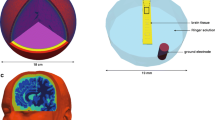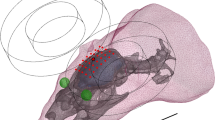Abstract
A resistor mesh model (RMM) has been validated with reference to the analytical model by consideration of a set of four dipoles close to the cortex. The application of the RMM to scalp potential interpolation was detailed in Part 1. Using the RMM and the same four dipoles, the different methods of cortical mapping were compared and have shown the potentiality of this RMM for obtaining current and potential cortical distributions. The lead-field matrices are well-adapted tools, but the use of a square matrix of high dimension does not permit the inverse solution to be improved in the presence of noise, as a regularisation technique is necessary with noisy data. With the RMM, the transfer matrix and the cortical imaging technique proved to be easy to implement. Further development of the RMM will include application to more realistic head models with more accurate conductivities.
Similar content being viewed by others
References
Ahlfors, S. P., Simpson, G. V., Dale, A. M., Belliveau, J. W., Liu, A. K., Korvenoja, A., Virtanen, J., Huotilainen, M., Tootell, R. B., Aronen, H. J., andIlmoniemi, R. J. (1999): ‘Spatiotemporal activity of a cortical network for processing visual motion revealed by MEG and fMRI,’J Neurophysiol,82, pp. 2545–2555
Alecu, T., Voloshynovskiy, S., andPun, T. (2004): ‘EEG cortical imaging: a vector field approach for Laplacian denoising and missing data estimation,’IEEE Int. Symp. Biomed. Imag., Arlington pp. 1335–1338
Babiloni, F., Babiloni, C., Carducci, F., Fattorini, L., Onorati, P., andUrbano, A. (1996): ‘Spline Laplacian estimate of EEG potentials over a realistic magnetic resonance-constructed scalp surface model,’Electroencephalogr. Clin. Neurophysiol.,98, pp. 363–373
Babiloni, F., Babiloni, C., Carducci, F., Fattorini, L., Anello, C., Onorati, P., andUrbano, A. (1997): ‘High resolution EEG: a new model-dependent spatial deblurring method using a realistically-shaped MR-constructed subject's head model,’Electroencephalogr. Clin. Neurophysiol.,102, pp. 69–80
Babiloni, F., Babiloni, C., Locche, L., Cincotti, F., Rossini, P. M., andCarducci, F. (2000a): ‘High-resolution electro-encephalogram: source estimates of Laplacian-transformed somatosensory-evoked potentials using a realistic subject head model constructed from magnetic resonance images,’Med. Biol. Eng. Comput.,38, pp. 512–519
Babiloni, F., Carducci, F., Cincotti, F., Del Gratta, C., Roberti, G. M., Romani, G. L., Rossini, P. M., andBabiloni, C. (2000b): Integration of high resolution EEG and functional magnetic resonance in the study of human movement-related potentials,Methods Inf. Med.,39, pp. 179–182
Baillet, S., andGarnero, L. (1997): ‘A Bayesian approach to introducing anatomo-functional priors in the EEG/MEG inverse problem,’IEEE Trans. Biomed. Eng.,44, pp. 374–385
Bayford, R. H., Gibson, A., Tizzard, A., Tidswell, T., andHolder, D. S. (2001): ‘Solving the forward problem in electrical impedance tomography for the human head using IDEAS (integrated design engineering analysis software), a finite element modelling tool,’Physiol. Meas.,22, pp. 55–64
Carlson, S., Martinkauppi, S., Rama, P., Salli, E., Korvenoja, A., andAronen, H. J. (1998): ‘Distribution of cortical activation during visuospatial n-back tasks as revealed by functional magnetic resonance imaging,’Cereb Cortex,8, pp. 743–752
Dale, A. M., andSereno, M. (1993): ‘Improved localization of cortical activity by combining EEG and MEG with MRI cortical surface reconstruction: a linear approach,’J. Cogn. Neurosci.,5, pp. 162–176
Dale, A. M., Liu, A. K., Fischl, B. R., Buckner, R. L., Belliveau, J. W., Lewine, J. D., andHalgren, E. (2000): ‘Dynamic statistical parametric mapping: combining fMRI and MEG for high-resolution imaging of cortical activity,’Neuron,26, pp. 55–67
Edlinger, G., Wach, P., andPfurtscheller, G. (1998): ‘On the realization of an analytic high-resolution EEG,’IEEE Trans. Biomed. Eng.,45, pp. 736–745
Franceries, X., Doyon, B., Chauveau, N., Rigaud, B., Celsis, P., andMorucci, J. P. (2003): ‘Solution of Poisson's equation in a volume conductor using resistor mesh models: application to event related potential imaging,’J. Appl. Phys.,93, pp. 3578–3588
Freeman, W. J. (1980): ‘Use of spatial deconvolution ot compensate for distortion of EEG by volume conduction,’IEEE Trans. Biomed. Eng.,27, pp. 421–429
Gamma, A., Lehmann, D., Frei, E., Iwata, K., Pascual-Marqui, R. D., andVollenweider, F. X. (2004): ‘Comparison of simultaneously recorded [H2(15)O]-PET and LORETA during cognitive and pharmacological activation,’Hum. Brain Mapp.,22, pp. 83–96
Gevins, A. (1989): ‘Dynamic functional topography of cognitive tasks,’Brain Topogr.,2, pp. 37–56
Gevins, A., Le, J., Martin, N. K., Brickett, P., Desmond, J., andReutter, B. (1994): ‘High resolution EEG: 124-channel recording, spatial deblurring and MRI integration methods,’Electroencephalogr. Clin. Neurophysiol.,90, pp. 337–358
Gevins, A. (1998): ‘The future of electroencephalography in assessing neurocognitive functioning,’Electroencephalogr. Clin. Neurophysiol.,106, pp. 165–172
Grave de Peralta-Menendez, R., andGonzalez-Andino, S. L. (1998): ‘A critical analysis of linear inverse solutions to the neuroelectromagnetic inverse problem,’IEEE Trans Biomed. Eng.,45, pp. 440–448
Hamalainen, M., andIlmoniemi, R. J. (1984): ‘Interpreting measured magnetic fields of the brain: estimates of current distributions’.Report TKK-F-A559 Helsinki University of Technology, pp.
Haueisen, J., Ramon, C., Eiselt, M., Brauer, H., andNowak, H. (1997): ‘Influence of tissue resistivities on neuromagnetic fields and electric potentials studied with a finite element model of the head,’IEEE Trans. Biomed. Eng.,44, pp. 727–735
He, B., Wang, Y., Pak, S., andLing, Y. (1996): ‘Cortical source imaging from scalp electroencephalograms,’Med. Biol. Eng. Comput.,34, pp. 257–258
He, B., Wang, Y., andWu, D. (1997): ‘Imaging brain electrical activity using a 3-D realistically shaped inhomogeneous head model’,Proc IEEE/EMBS, pp. 1167–1169
He, B., Wang, Y., andWu, D. (1999): ‘Estimating cortical potentials from scalp EEG's in a realistically shaped inhomogeneous head model by means of the boundary element method,’IEEE Trans. Biomed. Eng.,46, pp. 1264–1268
Hjorth, B. (1975): ‘An on-line transformation of EEG scalp potentials into orthogonal source derivations,’Electroencephalogr. Clin. Neurophysiol.,39, pp. 526–530
Katznelson, R. D. (1981): ‘EEG recording, electrode placement, and aspects of generator localization,’ in Nunez, P. L. (Ed): Electric fields of the brain, The Neurophysics of EGG' (Oxford University, New York, 1981), Chap. 6.
Kearfott, R. B., Sidman, R. D., Major, D. J., andHill, C. D. (1991): “Numerical tests of a method for simulating electrical potentials on the cortical surface,’IEEE Trans. Biomed. Eng.,38, pp. 294–299
Kincses, W. E., Braun, C., Kaiser, S., andElbert, T. (1999): ‘Modeling extended sources of event-related potentials using anatomical and physiological constraints,’Hum. Brain Mapp.,8, pp. 182–193
Koles, Z. J., Kasmia, A., Paranjape, R. B., andMcLean, D. R. (1989): ‘Computed radial-current topography of the brain: patterns associated with the normal and abnormal EEG,’Electroencephalogr. Clin. Neurophysiol.,72, pp. 41–47
Law, S. K., Nunez, P. L., andWijesinghe, R. S. (1993): ‘High-resolution EEG using spline generated surface Laplacians on spherical and ellipsoidal surfaces,’IEEE Trans. Biomed. Eng.,40, pp. 145–153
Le, J., andGevins, A. (1993): ‘Method to reduce blur distortion from EEG's using a realistic head model,’IEEE Trans. Biomed. Eng.,40, pp. 517–528
Le, J., Menon, V., andGevins, A. (1994): ‘Local estimate of surface Laplacian derivation on a realistically shaped scalp surface and its performance on noisy data,’Electroencephalogr. Clin. Neurophysiol.,92, pp. 433–441
Liu, A. K., Belliveau, J. W., andDale, A. M. (1998): ‘Spatiotemporal imaging of human brain activity using functional MRI constrained magnetoencephalography data: Monte Carlo simulations,’Proc. Natl. Acad. Sci. USA,95, pp. 8945–8950
Meijs, J. W., Weier, O. W., Peters, M. J., andvan Oosterom, A. (1989): ‘On the numerical accuracy of the boundary element method,’IEEE Trans. Biomed. Eng.,36, pp. 1038–1049
Nunez, P. L. (1981): ‘Electric fields of the brain’ (Oxford University Press, New York, 1981), pp. 196–203
Nunez, P. L. (1989): ‘Estimation of large scale neocortical source activity with EEG surface Laplacians,’Brain Topogr.,2, pp. 141–154
Nunez, P. L., Silberstein, R. B., Cadusch, P. J. andWijesinghe, R. (1993): ‘Comparison of high resolution EEG methods having different theoretical bases,’Brain Topogr.,5, pp. 361–364
Nunez, P. L., Silberstein, R. B., Cadusch, P. J., Wijesinghe, R. S., Westdorp, A. F., andSrinivasan, R. (1994): ‘A theoretical and experimental study of high resolution EEG based on surface Laplacians and cortical imaging,’Electroencephalogr. Clin. Neurophysiol.,90, pp. 40–57
Nunez, P. L. (1995): “Neocortical dynamics and human EEG rhythms,’ (Oxford University Press, New York, 1995), pp.
Ollikainen, J. O., Vauhkonen, M., Karjalainen, P. A., andKaipio, J. P. (2001): ‘A new computational approach for cortical imaging,’IEEE Trans. Med. Imag.,20, pp. 325–332
Oostendorp, T. F., andvan Oosterom, A. (1996): ‘The surface Laplacian of the potential: theory and application,’IEEE Trans. Biomed. Eng.,43, pp. 394–405
Pascual-Marqui, R. D., Gonzalez-Andino, S. L., Valdes-Sosa, P. A., andBiscay-Lirio, R. (1988): ‘Current source density estimation and interpolation based on the spherical harmonic Fourier expansion,’Int. J. Neurosci.,43, pp. 237–249
Pascual-Marqui, R. D., Michel, C. M., andLehmann, D. (1994): ‘Low resolution electromagnetic tomography: a new method for localizing electrical activity in the brain,’Int. J. Psychophysiol.,18, pp. 49–65
Perrin, F., Pernier, J., Bertrand, O., andEchallier J. F. (1989): ‘spherical splines for scalp potential and current density mapping,’Electroencephalogr. Clin. Neurophysiol.,72, pp. 184–187
Scherg, M., von Cramon, D., andElton, M. (1984): ‘Brain-stem auditory-evoked potentials in post-comatose patients after severe closed head trauma,’J. Neurol.,231, pp. 1–5
Sidman, R. D., Ford, M. R., Ramsey, G., andSchlichting, C. (1990): ‘Age-related features of the resting and P300 auditory evoked responses using the dipole localization method and cortical imaging technique,’J. Neurosci. Methods,33, pp. 23–32
Sidman, R. D., Vincent, D. J., Smith, D. B., andLee, L. (1992): ‘Experimental tests of the cortical imaging technique-applications to the response to median nerve stimulation and the localization of epileptiform discharges,’IEEE Trans. Biomed. Eng.,39, pp. 437–444
Srebro, R., Oguz, R. M., Hughlett, K., andPurdy, P. D. (1993): ‘Estimating regional brain activity from evoked potential fields on the scalp,’IEEE Trans. Biomed. Eng.,40, pp. 509–516
Srebro, R. (1996): ‘An iterative approach to the solution of the inverse problem,’Electroencephalogr. Clin. Neurophysiol.,98, pp. 349–362
Srinivasan, R., Nunez, P. L., Tucker, D. M., Silberstein, R. B., andCadusch, P. J. (1996): ‘Spatial sampling and filtering of EEG with spline laplacians to estimate cortical potentials,’Brain Topogr.,8, pp. 355–366
Tuch, D. S., Wedeen, V. J., Dale, A. M., George, J. S., andBelliveau, J. W. (2001): ‘Conductivity tensor mapping of the human brain using diffusion tensor MRI,’Proc. Natl. Acad. sci. USA,98, pp. 11697–11701
van Burik, M., Edlinger, G., Peters, M., andPfurtscheller, G. (1997): ‘Calculating cortical potentials using the boundary element method,’Biomedizinische Technik, Band 42, Erganzungsband,1, pp. 185–188
Wahba, G. (1981): ‘Spline interpolation and smoothingon the sphere,’SIAM J. Sci. Stat. Comput., pp. 5–16
Wahba, G. (1982): ‘Erratum: Spline interpolation and smoothing on the sphere,’SIAM J. Sci. Stat. Comput., pp. 385–386
Wang, J. Z., Williamson, S. J., andKaufman, L. (1992): ‘Magnetic source images determined by a lead-field analysis: the unique minimum-norm least-squares estimation,’IEEE Trans. Biomed. Eng.,39, pp. 665–675
Wang, Y., andHe, B. (1998): ‘A computer simulation study of cortical imaging from scalp potentials,’IEEE Trans. Biomed. Eng.,45, pp. 724–735
Yamashita, Y. (1982): ‘Theoretical studies on the inverse problem in electrocardiography and the uniqueness of the solution,’IEEE Trans. Biomed. Eng.,29, pp. 719–725
Yamashita, Y., andTakahashi, T. (1984): ‘Use of the finite element method to determine epicardial from body surface potentials under a realistic torso model,’IEEE Trans. Biomed. Eng.,31, pp. 611–621
Yao, D. (1996): ‘The equivalent source technique and cortical imaging,’Electroencephalogr. Clin. Neurophysiol.,98, pp. 478–483
Yvert, B., Bertrand, O., Echallier, J. F., andPernier, J. (1995): ‘Improved forward EEG calculations using local mesh refinement of realistic head geometries,’Electroencephalogr. Clin. Neurophysiol.,95, pp. 381–392
Zanow, F. (1997): ‘Realistically shaped models of the head and their applications to EEG and MEG’. Ph.D. thesis, University of Twente
Zhang, X., van Drongelen, W., Hecox, K. E., Towle, V. L., Frim, D. M., McGee, A. B., andHe, B. (2003): ‘High-resolution EEG: cortical potential imaging of interictal spikes,’ Clin. Neurophysiol.,114, pp. 1963–1973
Zhao, F., andWu, D. (1998): ‘A new realistic geometry spline Laplacian algorithm and its application to VER’,20th IEEE/MBS, Hong Kong, pp.
Zubal, I. G., Harrell, C. R., Smith, E. O., Ratiner, Z., Gindi, G., andHoffer, P. B. (1994): ‘Computerized three-dimensional segmented human anatomy,’Med. Phys.,21, pp. 299–302
Author information
Authors and Affiliations
Corresponding author
Rights and permissions
About this article
Cite this article
Chauveau, N., Morucci, J.P., Franceries, X. et al. Resistor mesh model of a spherical head: Part 2: A review of applications to cortical mapping. Med. Biol. Eng. Comput. 43, 703–711 (2005). https://doi.org/10.1007/BF02430946
Received:
Accepted:
Issue Date:
DOI: https://doi.org/10.1007/BF02430946




